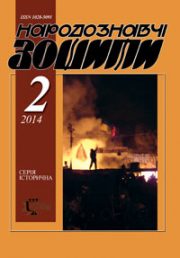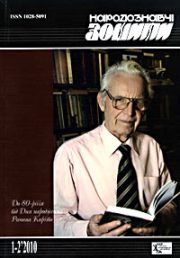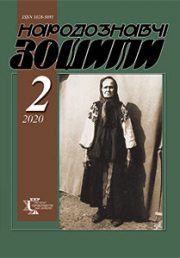The Ethnology Notebooks. 2017, 4 (136), 835–842
UDK [394.3:398.33](477.54/.62+477.52).:130.2
DOI https://doi.org/10.15407/nz2017.04.835
THE GROUP WALK IN CALENDAR RITUALIZM OF SLOBODA UKRAINIANS AS THE CULTURAL PRACTICE
Oliynyk Natalia — graduate student of department
of direction of the Kharkiv state academy of culture.
Lowering of bursa, 4, Kharkiv, 61057, Ukraine
Contacts: tel. (057) 731-13-85; E-mail: rector@ic.ac.kharkov.ua
Abstract. The group walk is considered to be an element of traditional ritualism. There are certain kinds of the walk such as in a straight line, in a circle and arbitrarily, and by a specific trajectory which are analyzed. During performing of any type of the walk the ritual action would gain sacral and magical meaning. For strengthening its effect declamation, singing, attributes (sacral; specially made for a holiday; certain objects or things which gained sacral meaning during a ritual) were used. Eventually, the group walk changed on a contrary to the traditional one and gained the new form and the new significance: an accurate breakdown into the columns and lines, and a ceremonial walk down the streets. In modern cultural practices the walk is also a part of common events but it lost its sacral and magical significance.
Keywords: group walk, calendar ritualism, sacral and magical actions, change, cultural practices.
Received 15.06.2017
REFERENCES
Agapkina, T. A. (2002). Mifopojeticheskie osnovy slavjanskogo narodnogo kalendarja. Vesenne-letnij cikl. Moskva: Indrik [in Russian].
Anichkov, E. V. (1903). Vesennjaja obrjadovaja pesnja na zapade i u slavjan: v 2-h chastjah. Ch. 1. Ot obrjada k pesne. Sankt-Peterburg [in Russian].
Bondarenko, G. B. (1983). Vzaimosvjaz’ trudovyh prazdnikov, obrjadov i kalendarnoj obrjadnosti naroda. Tradicii, obrjady, sovremennost’. Kiev: Izd. politicheskoj literatury. S. 246–253 [in Russian].
Voropaj, O. (1991). Zvychai nashoho narodu. Etnohrafichnyj narys: u 2-kh kn. Kn. II. Kyiv: Oberih [in Ukrainian].
Hrushevs’kyj, M. S. (1993). Istoriia ukrains’koi literatury: v 6 t., 9 kn. T. I. Kyiv: Lybid’ [in Ukrainian].
Gusev, V. E. (1977). Istoki russkogo narodnogo teatra. LGITMIK [in Russian].
Dal’, V. I. (1978). Tolkovyj slovar’ zhivogo velikorusskogo jazyka: v 4-h t. T. І.Moskva: Russkijjazyk [in Russian].
Dikarjov, M. (1905). Narodnij kalendar Valujs’koho povitu (Borysivs’koi volosty). u Voronezhchyni. Materialy do ukrains’korosijs’koi etnolohii. T. VI. L’viv. S. 114–204 [in Ukrainian].
Zhajvoronok, V. V. (2006). Znaky ukrains’koi etnokul’tury. Slovnyk-dovidnyk. Kyiv: Dovira [in Ukrainian].
Ivanov, P. V. (2007). Zhizn’ i pover’ja krest’jan Kupjanskogo uezda Har’kovskoj gubernii. Har’kov: Majdan [in Russian].
Ivleva, L. M. (1998). Doteatral’noigrovoj jazyk russkogo fol’klora. Sankt-Peterburg [in Russian].
Ihnatenko, I. V. (2013). Zhinoche tilo u tradytsijnij kul’turi ukraintsiv. Kyiv: Duliby [in Ukrainian].
Kylymnyk, S. (1994). Ukrains’kyj rik u narodnykh zvychaiakh v istorychnomu osvitlenni: u 3 kn., 6 t. Kn. II. T. 3 (Vesnianyj tsykl).. Kyiv: Oberehy [in Ukrainian].
Klymets’, Yu. D. (1990). Kupal’s’ka obriadovist’ na Ukraini. Kyiv: Naukova dumka.
Kurochkin, O. V. (1978). Novorichni sviata ukraintsiv. Tradytsii i suchasnist’. Kyiv: Naukova dumka [in Ukrainian].
Kurochkin, O. V. (1995). Ukrains’ki novorichni obriady: «Koza» i «Malanka» (z istorii narodnykh masok). Opishne [in Ukrainian].
Lotman, Ju. M. (2000). Vnutri mysljashhih mirov. Semiosfera. Sankt-Peterburg [in Russian].
Morozov, I. A. (2004). Krug igry. Prazdnik i igra v zhizni severorusskogo krest’janina (XIX–XX vv.).. I. A. Morozov& I. S. Slepcova. Moskva: Indrik [in Russian].
Muravs’kym shliakhom. Ch. 1. Etnohrafichnyj opys ta fol’klorni materialy selyscha Lyman Zmiivs’koho rajonu Kharkivs’koi oblasti (1996). Uporiad. M. M. Krasykov, N. P. Olijnyk, V. M. Osadcha& M. O. Semenova. Kharkiv [in Ukrainian].
Obriadovi pisni Slobozhanschyny (Sums’kyj rehion). (2005). Fol’klorni zapysy ta uporiadkuvannia V. V. Dubravina. Sumy: Universytets’ka knyha [in Ukrainian].
Olijnyk N. P. (2016). Mahichnist’ symvoliky hurtovoi khody v kalendarnij obriadovosti ukraintsiv Slobozhanschyny. Kul’tura ta informatsijne suspil’stvo XXI stolittia: materialy vseukrains’koi nauk.-teoretych. konf. molodykh uchenykh, 21–22 kvitnia 2016 r. Kharkiv: KhDAK. S. 243–245 [in Ukrainian].
Pol’s’kyj, I. S. (1971). Pro vykorystannia tradytsijnoi koliadnoi obriadovosti u stvorenni novykh obriadiv. Kharkiv [in Ukrainian].
Radians’ki sviata i obriady v komunistychnomu vykhovanni. (1978). Kyiv: Vyd. politychnoi literatury Ukrainy [in Ukrainian].
Sviata ta obriady Radians’koi Ukrainy (1971). Kuven’ova, O. F., Kravets’, O. M., Hirnyk, T. D.& Zinych, V. T. Kyiv: Naukova dumka [in Ukrainian].
Slavjanskie drevnosti. Jetnolingvisticheskij slovar’: v 5-ti t. (2004). Pod obshhej red. N. I. Tolstogo. T. 3. Moskva: Mezhdunarodnye otnoshenija [in Russian].
Smoliak, O. S. (2004). Vesniana obriadovist’ Zakhidnoho Podillia v konteksti ukrains’koi kul’tury: monohrafiia. Ch. I. Ternopil’: Aston [in Ukrainian].
Toporkov, A. L. (1989). Simvolika i ritual’nye funkcii predmetov material’noj kul’tury. Jetnograficheskoe izuchenie znakovyh sredstv kul’tury. Sbornik nauchnyh trudov. Otv. red. A. S. Myl’nikov. Leningrad: Nauka. S. 89–101 [in Russian].
Tradytsijna narodna kul’tura Dvorichans’koho rajonu Kharkivs’koi oblasti (2001). Uporiad. M. O. Semenova. Kharkiv: Rehion-inform. [in Ukrainian].
Horeografija v narodnom prazdnike (Na osnove narodnoj tradicii vesenneletnih horovodnyh igrishh).. Metodicheskie rekomendacii (1986). Avtorsost. T. N. Skrynnik. Moskva [in Russian].
Chicherov, V.I. (1957). Zimnij period russkogo zemledel’cheskogo kalendarja XVІ–XIX vekav. Ocherki po istorii narodnih verovanij. Moskva [in Russian].
Chesnov, Ja. V. (1989). Shag Majtrejn: nekotorye aspekty izuchenija kinesiki. Jetnograficheskoe izuchenie znakovyh sredstv kul’tury. Leningrad. S. 122–138 [in Russian].
Shhepanskaja, T. B. (2003). Kul’tura dorogi v russkoj miforitual’noj tradicii XIX–XX vv. Moskva: Indrik [in Russian].






